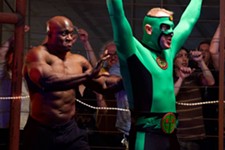
The Look of Silence
2015, PG-13, 103 min. Directed by Joshua Oppenheimer.
REVIEWED By Marc Savlov, Fri., Aug. 14, 2015
Some documentary films are so emotionally devastating as to be almost unbearable to watch, and yet watch them we must. Claude Lanzmann’s Shoah, which chronicles the horrific, day-by-day, death-by-death minutiae of the Holocaust by conducting lengthy interviews with victims and victimizers is one example. Another is Alex Gibney’s Academy Award-winning examination of the more recent Bush/Cheney presidency’s nightmarish use of “extraordinary renditions” to fight a confused, bull-headed war on terror (Taxi to the Dark Side). Joshua Oppenheimer’s The Look of Silence is another.
A sequel of sorts to his much-lauded 2012 doc The Act of Killing – in which the director trained his camera on the perpetrators of the little-remembered, anti-Communist genocide in Indonesia that claimed some one million lives in 1965 – Oppenheimer here chooses to return to the scene of the crimes and view them through interviews with surviving family members and their now middle-aged children. If anything, this directorial tack is even more distressing than the first film’s images of the killers, who are still in positions of regional power after half a century, and giddily re-enact their horrendous butchery for Oppenheimer’s cameras.
This time, Oppenheimer narrows the focus to one man, Adi Rukun, an ophthalmologist who travels around the Snake River area asking uncomfortable questions of the perpetrators under the guise of giving them eye examinations. To a one, the killers remain boastful of their crimes while simultaneously exhorting Rukun (and by extension Indonesia and the world) to believe that “the past is past” and to not open “an old wound” that has long since healed. Of course, in reality (specifically, the survivors’ reality), no such healing has ever remotely occurred. Imagine Germany if the Nazis had won and everyone had just put all that Holocaust unpleasantness behind them. That’s the general tone of the bloodthirsty (the death squads literally drank their victims’ blood) madness on parade here, and it’s more than enough to give you serious doubts about the fundamental goodness of mankind, if you don’t have those doubts already.
Still, Oppenheimer’s film is awash in stunning images that are often tonally contradictory to the ghastly testimonies that follow: the once blood-filled Snake River streaming along placidly and peacefully at dusk or the interstitial compositions that herald another awful recounting. Yet, by themselves, the images invoke visions of lush, tropical beauty or perverse comedy when an elderly death squad leader peeks out from behind a portable red refracting phoropter and offhandedly recalls, in terrible detail, the slaughter of Rokum’s own brother. The eye doctor’s eternal question – “Better … worse? Better … worse?” – takes on a dreadful new meaning in this harrowing and important documentary. The only sane answer is “worse.”
See "Confrontational Cinema," Aug. 14, for an interview with the director.
A note to readers: Bold and uncensored, The Austin Chronicle has been Austin’s independent news source for over 40 years, expressing the community’s political and environmental concerns and supporting its active cultural scene. Now more than ever, we need your support to continue supplying Austin with independent, free press. If real news is important to you, please consider making a donation of $5, $10 or whatever you can afford, to help keep our journalism on stands.
William Goss, Sept. 22, 2014
Richard Whittaker, Aug. 14, 2015
Marjorie Baumgarten, Aug. 9, 2013
Aug. 7, 2022
April 29, 2022
The Look of Silence, Joshua Oppenheimer











